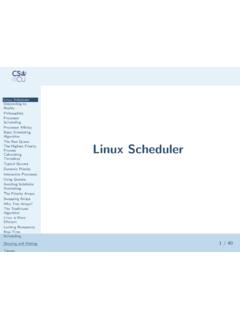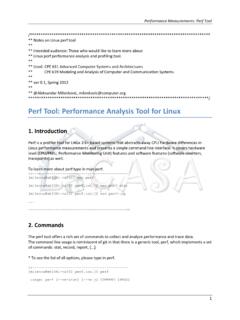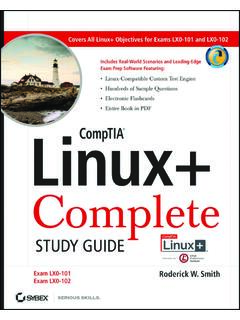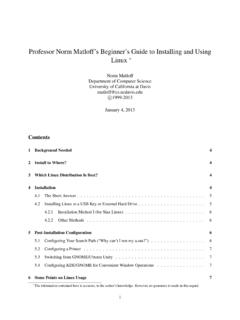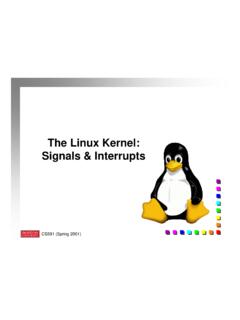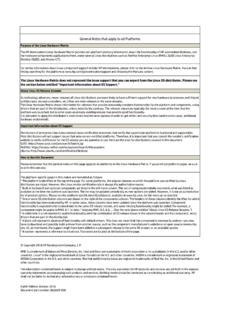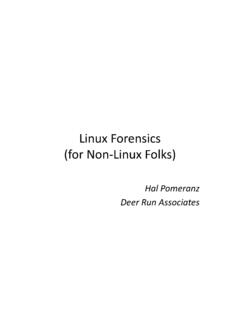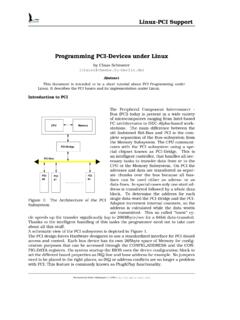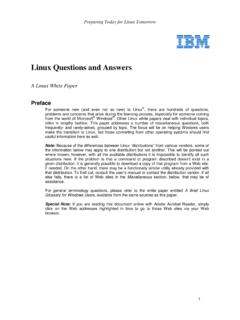Transcription of Interrupts)in)Linux)
1 interrupts in linux COMS W4118 Prof. Kaustubh R. Joshi ~krj/os 2/13/13 COMS W4118. Spring 2013, Columbia University. Instructor: Dr. Kaustubh Joshi, AT&T Labs. 1 References: OperaWng Sys Concepts 9e, Understanding the linux Kernel, previous W4118s Copyright no2ce: care has been taken to use only those web images deemed by the instructor to be in the public domain. If you see a copyrighted image on any slide and are the copyright owner, please contact the instructor. It will be removed. Why interrupts ? Devices require a prompt response from the CPU when various events occur, even when the CPU is busy running a program Need a mechanism for a device to gain CPU s aFenWon The Kernel as a MulWthreaded Server I/O device Timer Process Process Process Kernel Data structures In common address space Syscall Syscall Interrupt Overview interrupts and ExcepWons ExcepWon Types and Handling Interrupt Request Lines (IRQs) Programmable Interrupt Controllers (PIC) Interrupt Descriptor Table (IDT) Interrupt Handling SoaIRQs, Tasklets Work Queues interrupts Forcibly change normal flow of control Similar to context switch (but lighter weight)
2 Hardware saves some context on stack; Includes interrupted instrucWon if restart needed Enters kernel at a specific point; kernel then figures out which interrupt handler should run ExecuWon resumes with special iret instrucWon Many different types of interrupts Types of interrupts (x86 terminology) Asynchronous From external source, such as I/O device Not related to instrucWon being executed Synchronous (also called excep/ons) Processor- detected excepWons: Faults correctable; offending instrucWon is retried Traps oaen for debugging; instrucWon is not retried Aborts major error (hardware failure) Programmed excepWons: Requests for kernel intervenWon (soaware intr/syscalls) Faults InstrucWon would be illegal to execute Examples.
3 WriWng to a memory segment marked read- only Reading from an unavailable memory segment (on disk) ExecuWng a privileged instrucWon Detected before incremenWng the IP The causes of faults can oaen be fixed If a problem can be remedied, then the CPU can just resume its execuWon- cycle Traps A CPU might have been programmed to automaWcally switch control to a debugger program aaer it has executed an instrucWon That type of situaWon is known as a trap It is acWvated a;er incremenWng the IP Error ExcepWons Most error excepWons divide by zero, invalid operaWon, illegal memory reference, etc. translate directly into signals This isn t a coincidence.
4 The kernel s job is fairly simple: send the appropriate signal to the current process force_sig(sig_number, current); That will probably kill the process, but that s not the concern of the excepWon handler One important excepWon: page fault An excepWon can (infrequently) happen in the kernel die(); // kernel oops x86 CPU Master PIC (8259) Slave PIC (8259) INTR Programmable Interval- Timer Keyboard Controller Real- Time Clock Legacy PC Design (for single- proc systems) SCSI Disk Ethernet l I/O devices have (unique or shared) Interrupt Request Lines (IRQs) l IRQs are mapped by special hardware to interrupt vectors, and passed to the CPU l This hardware is called a Programmable Interrupt Controller (PIC)
5 IRQs Interrupt Hardware The `Interrupt Controller Responsible for telling the CPU when a specific external device wishes to interrupt Needs to tell the CPU which one among several devices is the one needing service PIC translates IRQ to vector Raises interrupt to CPU Vector available in register Waits for ack from CPU interrupts can have varying prioriWes PIC also needs to prioriWze mulWple requests Possible to mask (disable) interrupts at PIC or CPU Early systems cascaded two 8 input chips (8259A) Example: interrupts on 80386 80386 core has one interrupt line, one interrupt acknowledge line Interrupt sequence: Interrupt controller raises INT line 80386 core pulses INTA line low, allowing INT to go low 80386 core pulses INTA line low again, signaling controller to put interrupt number on data bus INT:INTA:Data bus:Interrupt #MulW- CORE CPU MulWple Logical Processors CPU 0 CPU 1 I/O APIC LOCAL APIC LOCAL APIC Advanced Programmable Interrupt Controller is needed to perform rouWng of I/O requests from peripherals to CPUs (The legacy PICs are masked when the APICs are enabled) APIC, IO- APIC, LAPIC Advanced PIC (APIC) for SMP systems Used in all modern systems interrupts routed to CPU over system bus IPI.
6 Inter- processor interrupt Local APIC (LAPIC) versus frontend IO- APIC Devices connect to front- end IO- APIC IO- APIC communicates (over bus) with Local APIC Interrupt rouWng Allows broadcast or selecWve rouWng of interrupts Ability to distribute interrupt handling load Routes to lowest priority process Special register: Task Priority Register (TPR) Arbitrates (round- robin) if equal priority Assigning IRQs to Devices IRQ assignment is hardware- dependent SomeWmes it s hardwired, someWmes it s set physically, someWmes it s programmable PCI bus usually assigns IRQs at boot Some IRQs are fixed by the architecture IRQ0: Interval Wmer IRQ2: Cascade pin for 8259A linux device drivers request IRQs when the device is opened Note: especially useful for dynamically- loaded drivers, such as for USB or PCMCIA devices Two devices that aren t used at the same Wme can share an IRQ, even if the hardware doesn t support simultaneous sharing Assigning Vectors to IRQs Vector.
7 Index (0- 255) into interrupt descriptor table Vectors usually IRQ# + 32 Below 32 reserved for non- maskable intr & excepWons Maskable interrupts can be assigned as needed Vector 128 used for syscall Vectors 251- 255 used for IPI x86 Interrupt Handling via IDT PIC CPU Memory Bus INTR 0 N IRQs IDT 0 255 handler idtr Mask points vector Kernel must setup idtr during system startup (set- and- forget) LIDT and SIDT used to set/get the pointer to this table Interrupt Descriptor Table The entry- point to the interrupt- handler is located via the Interrupt Descriptor Table (IDT) IDT: gate descriptors, one per vector Address of handler Current Privilege Level (CPL) Descriptor Privilege Level (DPL) Gates (slightly different ways of entering kernel) Task gate: includes TSS to transfer to (not used by linux ) Interrupt gate: disables further interrupts Trap gate: further interrupts sWll allowed IDT IniWalizaWon IniWalized once by BIOS in real mode linux re- iniWalizes during kernel init Must not expose kernel to user mode access start by zeroing all descriptors linux lingo: Interrupt gate (same as Intel; no user access) Not accessible from user mode System gate (Intel trap gate.)
8 User access) Used for int, int3, into, bounds Trap gate (same as Intel; no user access) Used for excepWons Dispatching interrupts On entry hardware: Checks which vector? Get corresponding descriptor in IDT Find specified descriptor in GDT (for handler) Check privilege levels (CPL, DPL) If entering kernel mode, set kernel stack Save eflags, cs, (original) eip on stack Jump to appropriate handler Assembly code prepares C stack, calls handler On return ( iret): Restore registers from stack If returning to user mode, restore user stack Clear segment registers (if privileged selectors) Interrupt Masking Two different types: global and per- IRQ Global delays all interrupts SelecWve individual IRQs can be masked selecWvely SelecWve masking is usually what s needed interference most common from two interrupts of the same type Nested interrupts What if a second interrupt occurs while an interrupt rouWne is excuWng?
9 Generally a good thing to permit that is it possible? And why is it a good thing? Maximizing Parallelism You want to keep all I/O devices as busy as possible In general, an I/O interrupt represents the end of an operaWon; another request should be issued as soon as possible Most devices don t interfere with each others data structures; there s no reason to block out other devices Handling Nested interrupts As soon as possible, unmask the global interrupt As soon as reasonable, re- enable interrupts from that IRQ But that isn t always a great idea, since it could cause re- entry to the same handler IRQ- specific mask is not enabled during interrupt- handling Nested ExecuWon interrupts can be interrupted By different interrupts .
10 Handlers need not be reentrant No noWon of priority in linux Small porWons execute with interrupts disabled interrupts remain pending unWl acked by CPU ExcepWons can be interrupted By interrupts (devices needing service) ExcepWons can nest two levels deep ExcepWons indicate coding error ExcepWon code (kernel code) shouldn t have bugs Page fault is possible (trying to touch user data) First- Level Interrupt Handler Oaen in assembler Perform minimal, common funcWons: saving registers, unmasking other interrupts Eventually, undoes that: restores registers, returns to previous context Most important: call proper second- level interrupt handler (C program) Interrupt Handling Do as liFle as possible in the interrupt handler Defer non- criWcal acWons Wll later Three types of acWons: CriWcal: Top- half ( interrupts disabled briefly!)
